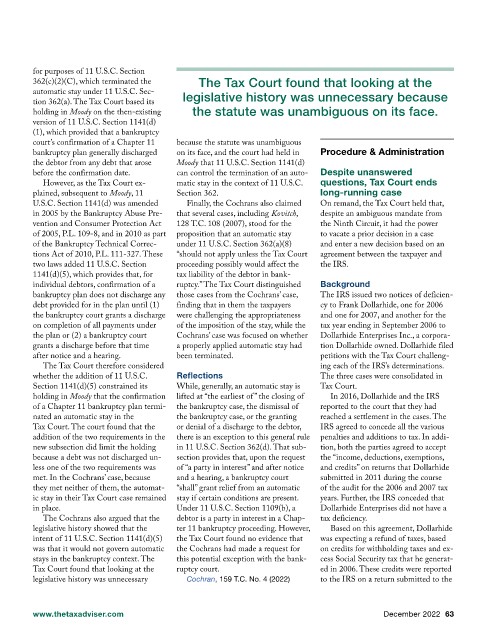Page 672 - TaxAdviser_2022
P. 672
for purposes of 11 U.S.C. Section
362(c)(2)(C), which terminated the The Tax Court found that looking at the
automatic stay under 11 U.S.C. Sec- legislative history was unnecessary because
tion 362(a). The Tax Court based its
holding in Moody on the then-existing the statute was unambiguous on its face.
version of 11 U.S.C. Section 1141(d)
(1), which provided that a bankruptcy
court’s confirmation of a Chapter 11 because the statute was unambiguous
bankruptcy plan generally discharged on its face, and the court had held in Procedure & Administration
the debtor from any debt that arose Moody that 11 U.S.C. Section 1141(d)
before the confirmation date. can control the termination of an auto- Despite unanswered
However, as the Tax Court ex- matic stay in the context of 11 U.S.C. questions, Tax Court ends
plained, subsequent to Moody, 11 Section 362. long-running case
U.S.C. Section 1141(d) was amended Finally, the Cochrans also claimed On remand, the Tax Court held that,
in 2005 by the Bankruptcy Abuse Pre- that several cases, including Kovitch, despite an ambiguous mandate from
vention and Consumer Protection Act 128 T.C. 108 (2007), stood for the the Ninth Circuit, it had the power
of 2005, P.L. 109-8, and in 2010 as part proposition that an automatic stay to vacate a prior decision in a case
of the Bankruptcy Technical Correc- under 11 U.S.C. Section 362(a)(8) and enter a new decision based on an
tions Act of 2010, P.L. 111-327. These “should not apply unless the Tax Court agreement between the taxpayer and
two laws added 11 U.S.C. Section proceeding possibly would affect the the IRS.
1141(d)(5), which provides that, for tax liability of the debtor in bank-
individual debtors, confirmation of a ruptcy.” The Tax Court distinguished Background
bankruptcy plan does not discharge any those cases from the Cochrans’ case, The IRS issued two notices of deficien-
debt provided for in the plan until (1) finding that in them the taxpayers cy to Frank Dollarhide, one for 2006
the bankruptcy court grants a discharge were challenging the appropriateness and one for 2007, and another for the
on completion of all payments under of the imposition of the stay, while the tax year ending in September 2006 to
the plan or (2) a bankruptcy court Cochrans’ case was focused on whether Dollarhide Enterprises Inc., a corpora-
grants a discharge before that time a properly applied automatic stay had tion Dollarhide owned. Dollarhide filed
after notice and a hearing. been terminated. petitions with the Tax Court challeng-
The Tax Court therefore considered ing each of the IRS’s determinations.
whether the addition of 11 U.S.C. Reflections The three cases were consolidated in
Section 1141(d)(5) constrained its While, generally, an automatic stay is Tax Court.
holding in Moody that the confirmation lifted at “the earliest of ” the closing of In 2016, Dollarhide and the IRS
of a Chapter 11 bankruptcy plan termi- the bankruptcy case, the dismissal of reported to the court that they had
nated an automatic stay in the the bankruptcy case, or the granting reached a settlement in the cases. The
Tax Court. The court found that the or denial of a discharge to the debtor, IRS agreed to concede all the various
addition of the two requirements in the there is an exception to this general rule penalties and additions to tax. In addi-
new subsection did limit the holding in 11 U.S.C. Section 362(d). That sub- tion, both the parties agreed to accept
because a debt was not discharged un- section provides that, upon the request the “income, deductions, exemptions,
less one of the two requirements was of “a party in interest” and after notice and credits” on returns that Dollarhide
met. In the Cochrans’ case, because and a hearing, a bankruptcy court submitted in 2011 during the course
they met neither of them, the automat- “shall” grant relief from an automatic of the audit for the 2006 and 2007 tax
ic stay in their Tax Court case remained stay if certain conditions are present. years. Further, the IRS conceded that
in place. Under 11 U.S.C. Section 1109(b), a Dollarhide Enterprises did not have a
The Cochrans also argued that the debtor is a party in interest in a Chap- tax deficiency.
legislative history showed that the ter 11 bankruptcy proceeding. However, Based on this agreement, Dollarhide
intent of 11 U.S.C. Section 1141(d)(5) the Tax Court found no evidence that was expecting a refund of taxes, based
was that it would not govern automatic the Cochrans had made a request for on credits for withholding taxes and ex-
stays in the bankruptcy context. The this potential exception with the bank- cess Social Security tax that he generat-
Tax Court found that looking at the ruptcy court. ed in 2006. These credits were reported
legislative history was unnecessary Cochran, 159 T.C. No. 4 (2022) to the IRS on a return submitted to the
www.thetaxadviser.com December 2022 63

